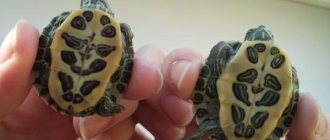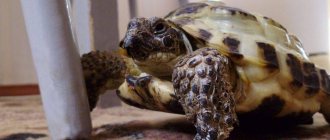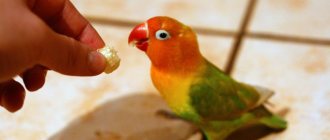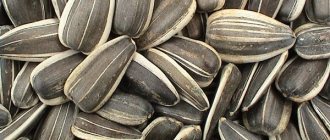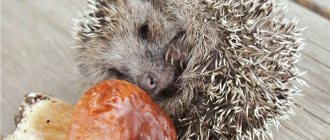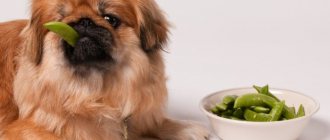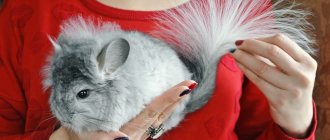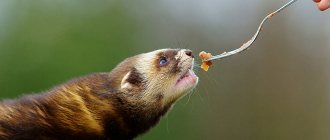Review author: “ZooVita”
Turtles are quite demanding and difficult reptiles to keep. And this applies, first of all, to their diet. Modern pet food manufacturers offer turtle owners a wide variety of “balanced” foods that make caring for their pet much easier.
However, in order to choose the right basic and additional diet and bait, it is necessary to understand in more detail what you can feed the turtle.
Theoretical aspects
Turtles belong to the class of reptiles and, according to their habitat, are divided into land, aquatic: freshwater and marine, semi-aquatic. In addition, according to the method of nutrition, three main groups are distinguished.
Each of these groups is characterized by an optimal ratio of feed of plant and animal origin, which must be taken into account when choosing a diet.
- Carnivores – animal food 70%-90%, plant food 10%-30%. These include almost all aquatic marine species and young freshwater turtles: red-eared, marsh, trionics, etc.;
- Herbivores – plant food up to 95%, animal food no more than 5%. Exclusively land turtles. Of the most popular species kept in captivity, we can note: Greek and Central Asian;
- Omnivores - the ratio of food of plant and animal origin is approximately equal. The same diet includes some types of young semi-aquatic and adult freshwater species, for example, red-legged, red-eared, etc.
How to properly feed a turtle depends not only on the group it belongs to, but also on its species and age. Choosing the wrong type of feed or a significant shift in feed ratio is guaranteed to lead to digestive disorders and metabolic diseases.
Food in natural habitat
In the wild, land turtles obtain their own food. This is, for the most part, plant food - grass, plant roots, berries, algae from the edges of reservoirs. Some part of the diet of wild turtles is protein food. These are worms, small insects, small snails.
The peculiarity of this reptile is that it can remain without food for quite a long time, storing significant reserves of it in its body during favorable seasons.
These animals are well versed in what vitamins, micro- and macroelements they lack at a certain stage of life and successfully find the products they need in the animal and plant world.
Predatory
The main diet consists of lean fish. As practice shows, the best choice is hake, pollock and cod from sea fish, as well as bream, bleak and perch from freshwater. There is no particular difference or preference between marine and freshwater species.
It is recommended to give your pet liver weekly. It can be either fish, beef or chicken. Young turtles need to cut the fish into small pieces. The spine can be left, but the ribs must be removed.
Adults can eat large pieces, and if the fish is small, then you can feed it whole.
The following food products can be used as additional feed:
- Seafood - octopus tentacles, shelled shrimp cephalothorax, small squid and mussels;
- Liver - including the liver of various animals, chicken or beef heart, as well as live food in the form of baby frogs or mice. It is strictly not recommended to feed turtles with meat, minced meat, sausages, etc.;
- Others (as a rule, given to young animals) - mealworms, food cockroaches, daphnia, snails without shells.
The food given to predatory turtles does not require heat treatment, that is, it must remain raw. First of all, this applies to various additives, for example, shrimp should be gray, not pink.
How often and at what time to feed
It is recommended to feed land turtles at the same time. For the first year of life, young individuals are fed 2 times a day, and adult representatives - every other day.
The volume of one serving is determined based on how much food she can eat in 30 minutes. Natural products are given in small pieces in the amount of 1-3 pieces. If the turtle does not eat a portion during a half-hour meal, next time you can slightly reduce the size of the pieces. In any case, the owner will have to focus on the individual appetite of the domestic reptile.
It is recommended to place food for the turtle in a special feeding bowl. You should not feed your reptile by hand. Uneaten pieces of food are removed, and the container is washed so that potentially dangerous microorganisms do not breed in it.
You should not feed your turtle spoiled or uneaten foods, as they can cause poisoning to the body.
Herbivores
Any vegetables, fruits, root vegetables or greens can be used as the main diet. Starting from dandelions and carrots (clover, thistle, alfalfa, regular lawn grass) and ending with a variety of lettuce, carrots, cabbage, etc.
When preparing a diet, take 2-3 times more greens than fruits and vegetables. As additives to the main food of herbivorous turtles, you can use bran, dry yeast or dried seaweed, and soybean chaff.
Drinking regime
Red-eared turtles from the family of freshwater turtles live in the wild in small lakes with well-warmed water by the sun or ponds with swampy shores. For these reptiles, fresh water is vital (they cannot live without it for even a couple of days). The redfish spends its entire life in water - activity and sleep, eating and the process of defecation.
The red-eared turtle spends its entire life in water - activity, sleep, eating
The question of whether a turtle has a need to drink has not been fully studied. The structural features of her body do not allow water to linger: in the process of drinking, it pours out of her nostrils and flows down her neck. Moisture, so necessary for reptiles, penetrates through its skin, as well as from the products it eats.
Omnivores
Despite the name, semi-aquatic and marsh turtles are the most demanding in terms of food composition. In addition, their diet can change significantly during the period of growing up.
The optimal composition of the diet depends solely on the type of turtle. In addition, it is necessary to determine how many times to feed small turtles, whose main diet consists of food of animal origin.
What can overfeeding cause?
An important condition for the nutrition of a red-eared pet is not only a variety of diet, but also a regime. Overfeeding leads to diseases: pyramidal shell and obesity.
Not only the diet, but also the regimen is considered an important condition for nutrition.
Overeating in juveniles is extremely harmful, because they are actively developing, as well as during the adaptation period after purchasing or after illness of a red-eared turtle.
It is not recommended to force feed turtles. But long-term fasting is also contraindicated for them.
A healthy reptile should swim freely in the water and easily crawl onto the island. Excess weight will prevent the turtle from hiding its head in its shell.
Ready-made dry food
Despite the assurances of some manufacturers about the complete self-sufficiency of the feed they produce, practice has shown that the optimal diet will be a combination of dry food and live feeding.
For example, if the diet of a fairly common red-eared turtle is dominated by live (especially fatty) fish, this is guaranteed to lead to an acute deficiency of vitamin E and the occurrence of steatitis.
Dry food that provides your pet with vitamin supplements in the proper quantities can lead to a significant lack of amino acids, which can lead to spasms of the jaw muscles - the turtle simply will not be able to open its mouth.
A balanced diet includes both factory-produced dry food and live food.
When choosing dry food for your pet, you need to take into account that some manufacturers' composition does not meet the animal's requirements.
As you can see in many photos of turtle food, the most common replacement is for animal products such as rather expensive fish and seafood with cheaper substitutes - fishmeal and various herbal additives.
Mr. Tail explains: foods prohibited for land turtles
The owner of these reptiles should be well aware of the foods that should never be given to pets:
- stone fruit seeds - apricots, peaches;
- citrus peel;
- plants that are poisonous and medicinal, such as buttercup, nightshade, potato and tomato tops, crocus, narcissus, milkweed, delphinium, hydrangea, mistletoe, dieffenbachia, azaleas, lilies, elodea;
- sausages and canned goods.
Porridge, baked goods, dairy products, eggs and eggshells, meat, onions, garlic, celery, spinach stems, radishes, and spicy herbs are allowed only in minimal quantities.
For aquatic turtles
The optimal diet of an aquatic turtle is much more complex than that of a land turtle. It should be borne in mind that full-fledged live feeding is quite difficult here, since in nature such animals feed exclusively on fresh fish.
And seafood, which is offered in domestic stores, goes through cycles of freezing and thawing several times. This leads to the destruction of nucleic acid proteins, as well as oligoelements, which are vital for the predatory sea turtle.
Therefore, the addition of dry food saturated with appropriate microelements is a prerequisite for creating a complete diet. It is imperative to check whether the food contains fat-soluble vitamin complexes, of which vitamins A and E are considered the most popular.
Do land turtles need water?
These reptiles, like other animals, require water for normal functioning. In nature, they get it from the stems and roots of plants, and also drink it when swimming in ponds.
There is no need to install special drinking bowls for a domestic reptile, but regular bathing should be organized. For some species, weekly water procedures are needed, for others it is enough to carry them out once a month. But it is still optimal to bathe pets once a week, and even more often in the hot season.
It is enough to pour warm water into a small container, not lower than +25 °C, and lower the pet there so that the liquid covers the entire upper shell and reaches at least the middle of the neck.
Photos of turtles
Errors
- If there are multiple turtles in a tank, some turtles may become malnourished. Monitor the feeding process of turtles, provide them with enough food.
- Plants collected from forests or grown at home are safer than greens found near the road, so feed your turtles plants that are safe.
- Don't overdo it with meat. Its excess leads to the development of rickets.
- Overfeeding is a common mistake for beginners. Monitor the amount of food offered to the animal.
- Be careful when identifying the type of turtle. If you are a beginner, consult with experienced aquarists. Incorrect identification of the species will lead to errors in diet preparation.
- An incorrect diet causes illness, disrupts metabolism and leads your pet to dehydration. A dehydrated animal needs frequent baths and water in the terrarium. A healthy animal does not need a drinking bowl.
- You cannot feed turtles by hand. Animals quickly get used to this method of feeding and do not eat on their own. The turtle will also begin to bite, associating hands with food.
- Loud noises and strong smells during feeding lead to digestive problems.
- A turtle's appetite for cheeses and bread does not indicate that it can be fed these foods.
Reproduction
In the spring comes marriage time. During this period, turtles (age 6–8 years and shell 9–12 cm) are far from water bodies. Turtles can also mate in water. The sperm of turtles can be stored in the female’s tract for up to 1 year or more; as a result, a female caught in the wild can “personally” lay completely full-fledged eggs after 5-6 months. Between May and July, females lay eggs three times in holes dug in the ground. During the season, the female produces 1–3 clutches. The depth of the pits is approximately 10 cm. The eggs that fall into them are beautiful: their shells are snow-white, they themselves have an oblong, regular shape, size 30 x 20 millimeters, weight approximately 8 g. In any clutch there are about 5–10 eggs, and they The female buries it most carefully. After approximately 2-3 months, these eggs produce tiny turtles about 24–25 millimeters long, weighing 5 g, with a large yolk sac on the belly.
The shell of young turtles is usually dark brown with yellow lines. They dig small tunnels near the nest, where they spend the winter in most cases. In the spring, turtles crawl out of their shelters onto the surface of the earth and begin an independent life. The incubation temperature is about 25–30°C and the duration is 54–90 days. Incubation humidity 90%. The water depth for newly born turtles is approximately 5 cm. Young individuals feed on daphnia and insect larvae.
Description
The low carapace (carapace) is almost oval; if you look at it from above, you can see that the width in the back is slightly wider than in the front. The length of the shell is 20 cm or more in adult large turtles. Since water has always been the key habitat for turtles, the carapace scutes naturally fit perfectly together. In terms of their structure, the carapace and plastron are completely streamlined and have no protrusions. Large claws are located on the legs, small membranes are located between the toes. The claws of a swamp turtle can easily tear prey apart and can significantly scratch your hand.
The tail of this turtle is relatively long, can reach 3/4 of the length of the carapace (about 12 cm) and during swimming it takes part as an auxiliary rudder during any turns (the main steering is carried out by the legs) and as a counterweight that holds the turtle in the required position during maneuvers. The carapace usually has a dark olive, dark green, sometimes almost black color, the plastron is light, yellowish. The shell, neck, head, legs are covered with small light spots. Often females have yellow eyes, while males are slightly reddish. Females have slightly shorter tails than males.
What is not recommended to include in the diet
The most dangerous foods for river turtles are from the human table, as well as food consumed by pets.
Never feed your reptiles the following types of food:
- vegetables;
- fruits;
- too fatty varieties of fish and meat.
You should also be especially careful when choosing insects and plants. Many types of them can be poisonous, while others can interfere with the normal process of calcium absorption or cause iodine deficiency.
If you follow all the necessary recommendations and nutritional tips, your pet will always be in a healthy state of mind. For him, the most important thing is a rich and balanced diet, and you can think through it yourself, the main thing is to first study its features.
Useful tips
- You need to feed your pets regularly. You cannot starve them for no apparent reason (such as moving, forced absence of the owner, etc.);
- Under no circumstances should you overfeed your turtle. If your pet is full and refuses an additional portion, do not insist!
- Pregnant individuals need to be fed at least once a day, similar to young animals. They require vitamin D, calcium, and multivitamins appropriate for their species;
- You cannot give a land animal specialized food for aquatic turtles, and vice versa!
- It is not recommended to give food cold; it is necessary to bring it to ambient temperature before feeding the pet;
- For aquatic turtles, food can be thrown directly into the aquarium, but be sure to make sure that there is no excess that will force you to change the water.
- Land animals can be taught to eat from tweezers.
- If your pet refuses to eat for more than two weeks, you should take him to the vet immediately.
- If possible, it is advisable to introduce aquarium fish (guppies, goldfish, swordtails) into the aquarium with turtles to maintain the hunting instinct.
- In the absence of algae, it is permissible to feed aquatic reptiles with lettuce or dandelion leaves.
- Young individuals prefer mainly food of animal origin, while older individuals are more inclined to eat plant foods.
- To maintain adequate levels of minerals, turtles are given bone meal daily, which is available in pet stores. For an adult reptile, the daily dose is 5 g of flour;
- To maintain the shell in a healthy condition, it is sprayed with a special spray “Nature's vita-sprey reptile” once every two days;
- Dry food should be selected based on its composition. Low quality feed is not recommended due to the lack of vitamins. It is not recommended to buy food containing fishmeal. You can give dry food to your pet no more than 3 times a day;
- It is preferable to feed vitamins before the main meal, when the reptile feels hungry;
- Oil vitamins can be dripped onto dry food. After it is saturated with the solution, throw it into the water.
